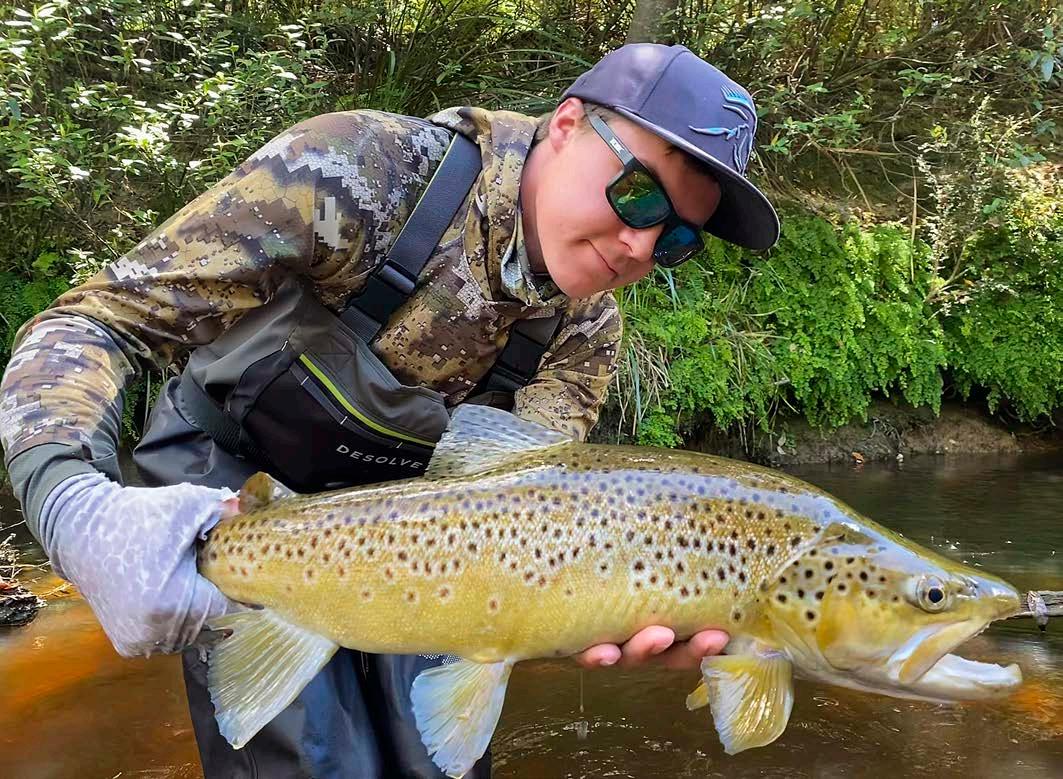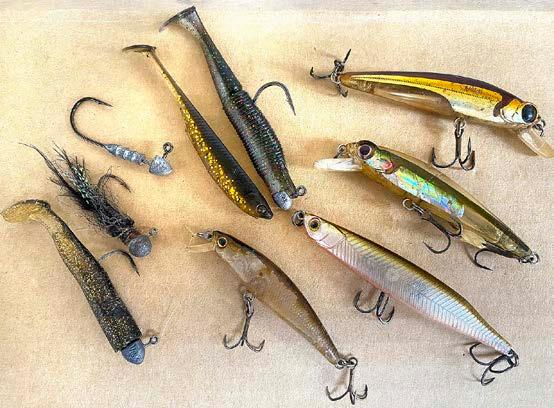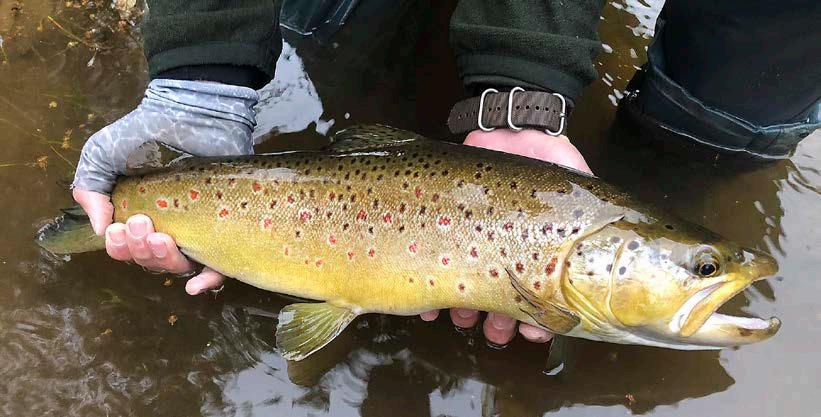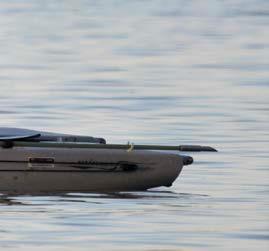
7 minute read
Big Trout - Small Rivers
Jonty Krushka
Once summer rolls around and I’m looking to target trout I generally turn my attention from the larger rivers and lagoons to smaller, faster flowing streams. Generally at this time of year, the water levels in the rivers have dropped and the clarity has improved making wading much easier. Fishing the smaller rivers often produces high numbers of smaller fish however bigger fish over the four-pound mark are not out of the question.
Areas to Look
One of the more difficult things can be finding the areas within kilometres of likely-looking rivers that will hold fish. Although a lot of rivers look very similar and there will be fish all through them, there are a few places I like to focus my efforts. Deep holes and deeper than average stretches of river are a favourite of mine during the warmer months. I’ve found the bigger fish often won’t stray too far from a deeper section of the river. They may not be sitting down deep in the middle of the hole but they will generally be sitting on the edge or at the head or tail of the pool. I’ve lost count of the number of times I’ve had multiple casts into a perfect-looking deep hole for nothing only to spook a solid fish out of 20 cm of water on the edge.
Other areas which often produce better than average fish are fallen trees and log jams. Logs running parallel to the flow as well as across the river are great spots to target. Larger log jams are also a great spot to target. Fish will sit in both the eddies behind the structure and also in front of the structure. I prefer to fish the front edge of the structure and let the current push my lure in underneath. As for logs running parallel to the flow fish will usually be sitting tight beside the log. Overhanging trees are another great piece of structure. They provide both shade and cover which trout love to sit under. This is especially the case on open stretches of river and bright days.
Areas of the river where it narrows and the current increases are other spots the fish will hang around. River bends are also a great area to target. These highflow sections of the river will also form undercut banks which are another place trout love to hang out. Flow can also be increased where small feeder creeks join the main river. This additional flow can often congregate fish in the area.
I have found that generally anything different in a stretch of the river tends to localise the fish. This could be a rocky section in a river that has very few rocks or a weed bed in a river with little weed. Weirs and road crossings are also spots that will often hold fish. As well searching for good structures watching for rises, and bust-ups and scanning the water for fish is also very important.
Fishing the River
By far my preferred way of fishing small streams and rivers is to hop in and wade. In a lot of the rivers I fish, wading is the only option as the banks are too overgrown to effectively fish along. Being in the river also allows for easier casting to both sides of the river and allows for easier snag retrieval which is inevitable when fishing overgrown, shallow, fast-flowing rivers. My usual approach is to get in the river and slowly fish my way upstream casting to all likely-looking spots. Big casts are not always the best strategy, often dangling the lure off the rod tip in front of a log jam will produce the biggest fish. I will usually fish through areas that don’t look so good pretty quickly and spend longer in the better-looking holes. However, it is always a good idea to cover all the water with at least one cast as quality fish will sometimes come from the most inconspicuous looking areas. Having a few extra casts in areas where you catch fish or see fish is definitely worth the time.
Although trout are not necessarily schooling fish, I have found they definitely tend to localise in particular stretches of the river. It’s not uncommon to walk a few hundred metres up a river without seeing a fish and then catch three or four in a 50-metre stretch. Even if the stretches of the river looked identical.

Lures and Techniques
I have used a wide variety of lures when chasing trout in the small rivers and they all have their pros and cons. Soft plastics are a great option as the depth they swim at can be controlled quite easily. In shallower snaggy areas I will often high stick my rod and wind quite fast and then drop the rod tip and slow down in deeper areas. Plastics are also great for sinking underneath the structure to fish that might be holding down deep. This versatility makes soft plastics a great choice in rivers which vary a lot in depth, flow rates and structure. Some of my favourite plastics for small river fishing are the Keitech 2-inch easy shiner, Savage slim minnow, Berkley t-tail and Daiwa baitjunkie 2.5inch minnow. I normally rig these on a 1/16th once jig head with a size 1 or size 2 hook. As for colours I prefer natural colours like black and gold, or greens and browns. I will normally fish soft plastics with a constant retrieve at a speed just faster than the current or whatever is required to stop the lure from getting snagged on the bottom.

Shallow diving hardbody minnows are another great option. They can generally be fished slower in the shallow snaggy areas than a soft plastic which can often entice a bite. They can also be floated into really snaggy territory without the risk of getting snagged up on the bottom. Having trebles can also improve hookup rates on small fish that are nipping at the tail of a soft plastic. My favourite hardbodies are the Cranka minnow and the Ecogear mx48 in any natural baitfish or trout colour. A slow roll is my favourite retrieve with a hardbody minnow.
Fishing surface lures is another great way to target small stream trout. At times trout can be very aggressive towards surface lures. I’ve had small fish launch completely out of the water like a Spanish mackerel when chasing down a surface lure. I have found slowflowing pools that are around half a metre to a metre deep with overhanging trees tend to be the best. Also, any area where a fish is rising is often a good place to throw a surface lure. These fish are already looking towards the surface and are normally more eager to eat a top water than fish holding close to the bottom or not actively feeding. My favourite surface lure is the Hurricane switch 66, small walk-the-dog style lures such as the Smith towadi are also effective. I normally work the surface lures with a classic walk-the-dog style retrieve, being a constant slow wind and short sharp twitches of the rod tip
A lure I have recently started using and have had some great success on is a fly tied onto a regular jig head. They are generally tied in the style of a woolly bugger or dog nobler in olive or black onto a 1/16th once size
2 hook jig head. I have found when fish are a little reluctant to commit to other lures these little jigs can normally convert follows and bites into hookups. I fish them with a similar retrieve to a surface lure, short sharp twitches of the rod tip whilst winding fast enough to keep it off the bottom.
Rod, Reel and Line
My go-to set up for fishing the smaller rivers is a light spin outfit, consisting of a six-foot eight-inch two-piece BKCustom rod, matched up with a 2500 size Daiwa reel. Some of the bush surrounding the rivers is very dense and overgrown, having a two-piece rod that can be broken in half makes bush bashing much easier than with a one-piece rod. The reel is spooled up with a four or six-pound braid and an FG knot connects a five or six-pound leader. I like to use a reasonably long leader of around 12 to 15 feet. The reason I do this is so if I get snagged somewhere that I can’t get to I can reach my leader and snap off the jig head without losing the leader as well. This saves the time of having to retie an FG knot and also stops the line from being left in the river.
Other Gear
There are a few other items that make chasing trout in the smaller rivers much easier. A good pair of breathable waders are arguably the most important. Not only do they keep you dry but they also stop you from getting cut to pieces when trudging through the bush and give some protection against snakes. Packing light when you are walking a long way through the rough country is a big advantage. Something that helps with this is a life straw. These water filtration devices are great for lightening the load and freeing up space in the backpack for more fishing gear. If you are fishing with someone else it can also be an advantage to take two nets. A small net that is easy to access can be very helpful when small fish take a lure right at the rod tip. Having a larger fold-out net is also a good idea in case a bigger fish comes along. A good pair of polarised sunnies is another vital piece of equipment. Not only will they help you to spot fish but they also help spot any trees or logs which can prevent snagging up and losing gear. Being able to clearly see where you’re going also helps prevent falling in and filling your waders up.

Targeting small river trout can be a great option on those summer days that are a bit too windy to get out on the blue water. The dense bush and river banks often offer a bit of protection from the wind and make fishing a lot more enjoyable than it would be anywhere else. Not to mention it’s often a very visual and super fun way of fishing.













